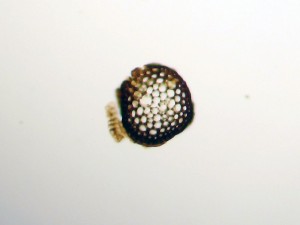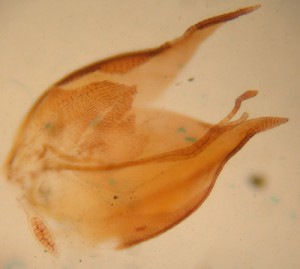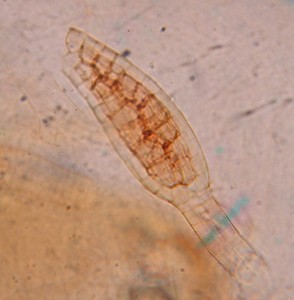Habitat
 Andreaea nivalis is mainly a rock-dweller, more or less restricted to granite. In this picture you can see the dark colored moss on the rock face.
Andreaea nivalis is mainly a rock-dweller, more or less restricted to granite. In this picture you can see the dark colored moss on the rock face.
Gametophyte
Overall structure:
This species is an acrocarpous moss and its shoots can either be irregularly branched or unbranched.
Leaf:
 The margins of the leaves are toothed while the cells of the lamina are thick-walled and pigmented brown. Furthermore, the leaves are costate and some are falcate-secund.
The margins of the leaves are toothed while the cells of the lamina are thick-walled and pigmented brown. Furthermore, the leaves are costate and some are falcate-secund.
Stem:
 As seen in this picture, there is little differentiation of cells within the stem cross-section.
As seen in this picture, there is little differentiation of cells within the stem cross-section.
Rhizoids:
 The rhizoids in Andreaea nivalis can either be uniseriate or biseriate (as in this picture).
The rhizoids in Andreaea nivalis can either be uniseriate or biseriate (as in this picture).
Perigonial plant:
 In this photograph, the arrow points to the perigonial branch.
In this photograph, the arrow points to the perigonial branch. 
Here is an antheridium and some paraphyses (uniseriate) within the perigonial branch. 
Here is a picture of an isolated antheridium of Andreaea nivalis.
Sporophyte
Overall structure:
 This moss is commonly named “toothless moss” due to the fact that it does not have any peristome teeth. Instead, the sporangium has four (or more) lines of dehiscence that surrounds a dome-shaped columella, as seen in this scanning electron micrograph. These longitudinal openings result in a structure that resembles a lantern, thereby earning theses mosses the nickname of “lantern mosses”.
This moss is commonly named “toothless moss” due to the fact that it does not have any peristome teeth. Instead, the sporangium has four (or more) lines of dehiscence that surrounds a dome-shaped columella, as seen in this scanning electron micrograph. These longitudinal openings result in a structure that resembles a lantern, thereby earning theses mosses the nickname of “lantern mosses”.
Spores:
The spores germinate endosporically, which means that the spore cell divides within the cell wall, creating a multicellular structure prior to the development of the protonema.
Seta:
 There is no seta in Andreaea nivalis. Instead, the sporangium is elevated by a pseudopodium, which is immersed within the perichaetial leaves and is gametophytic.
There is no seta in Andreaea nivalis. Instead, the sporangium is elevated by a pseudopodium, which is immersed within the perichaetial leaves and is gametophytic.
Protonema:
The protonema is branched and multiseriate in Andreaeopsida.
